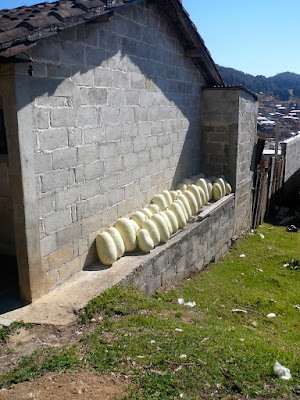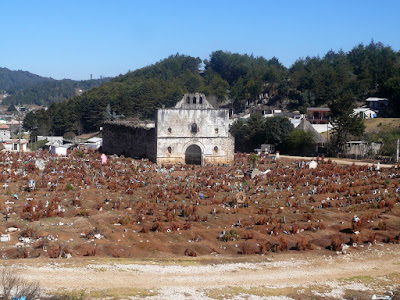|
|
|---|
Sunday, January 2, 2011
On the Saturday of our trip we took a tour to visit two Mayan communities outside of San Cristobal: San Juan Chamula and Zinacantan.
 |
| (cloudy) view of San Cristobal |
San Juan Chamula:
 |
| the arc signifies that the religious leader lives there |
 |
| stand used in religious ceremonies |
 |
| colonial-style house |
 |
| pre-hispanic style house |
 |
| pre-hispanic style house (right) next to a modern house (left) The pre-hispanic style houses can withstand earthquakes and easily be repaired, while the modern houses cannot. |
 |
| squash (calabaza) |
 |
| corn |
 |
| Mayan crosses |
The church in San Juan Chamula was incredible and an example of syncretism through its union of Catholic and indigenous beliefs . From the outside it appears to be a normal church -- though brightly colored.
 |
| church in San Juan Chamula |
However, the only Catholic tradition the community accepts is baptism. A priest comes on the weekends to perform baptisms, but otherwise they practice their indigenous religion. Inside the church (no photos allowed), the floor is covered in pine needles. The Mayans believe in an earthly realm and a spiritual realm, and by walking on the pine needles (as opposed to coming in direct contact with the floor), they believe they are able to enter into the spiritual realm. The statues of saints are dressed in indigenous clothing, and the community sees them as ancestors and part of history, not saints. There were a ton of lit candles throughout the church, mostly on the floor, and people chanting/praying in Tzotzil, their native language. There was also a cleansing/healing going on, during which a woman was chanting/praying and rubbing a live chicken all over the body of the man being cleansed/healed. (Apparently she killed the chicken at the end of the ceremony, though I did not see that part).
 |
| The females typically wear skirts made of wool because it gets so cold. |
 |
| Plaza outside of the church. The children and adults selling their wares were incredibly insistent. |
 |
| market outside of the church |
Drive to Zinacantan:
Zinacantan:
In Zinacantan we visited a home where the women weave and embroider to make colorful shirts, place mats, table runners, wall hangings, scarves, etc.
 |
| Karen modeling the traditional dress of the women in Zinacantan. Their name has something to do with"bat people", so the cloak represents bat wings. |
 |
| traditional hat-- the hat represents the sun and the ribbons represent the sun's rays |
 |
| traditional clothing of a bride and groom (middle) and the padrinos (family/friends chosen as wedding sponsors; left and right) |
 |
| The mother of the family was in the kitchen making tortillas. They were delicious and different than other tortillas I've had since they were fresh with no preservatives |
 |
| Our guide making tacos for each of us with fresh tortillas, beans, cheese and powder from pumpkin/squash seeds |
 |
| We tried pox/posh -- a traditional drink, usually used in religious ceremonies |
Labels: Chiapas, Mayan community, San Juan Chamula, Zinacantan
0 Comments:
Subscribe to:
Post Comments (Atom)





















